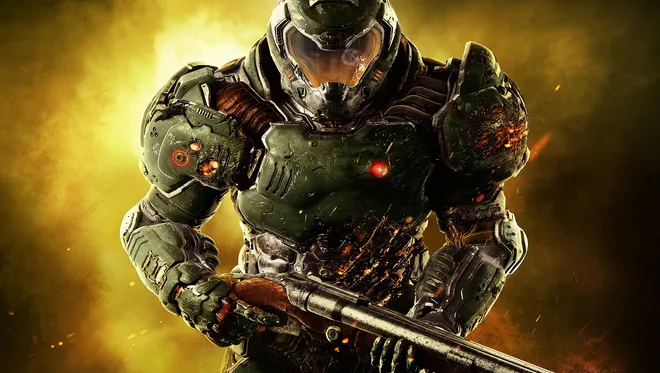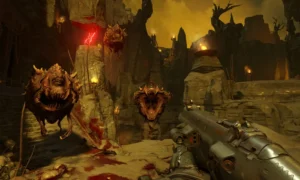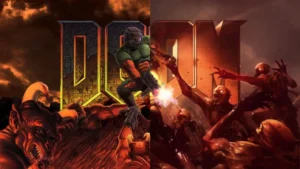
Review: Doom 2016- A Masterwork of Quick-Paced FPS
The 2016 revival of the venerable first-person shooter (FPS) series, Doom, was created by id Software and represents a victorious comeback for the genre. The single-player experience covered in this review re-creates the fast-paced, visceral action that made the original Doom games iconic while including contemporary improvements that maintain the gameplay’s interest and freshness.
 Narrative and Ambience
Narrative and Ambience
In Doom, the story is simple and unreservedly action-oriented. You take on the role of the Doom Slayer, an anonymous space marine who awakens on Mars to discover that demonic forces from Hell have taken over the Union Aerospace Corporation (UAC) facility. Killing any demon you see and halting the onslaught is your straightforward objective. Although the game embraces its simple plot and places a strong emphasis on combat, there are enough mythology nuggets strewn throughout for those who want to know more about the characters and world.
It’s a really gloomy vibe. Industrial Mars bases and the terrifying Hellish landscapes, complete with soaring buildings, gloomy lighting, and blood-soaked arenas, alternate as the scene changes. The settings are vibrant and teeming with sinister energy, and the sound design and graphics are excellent. Mick Gordon’s powerful, industrial metal soundtrack wonderfully captures the game’s fast-paced action.
 Playing games
Playing games
Fundamentally, Doom (2016) is a game that focusses on its fast-paced action and violent gameplay. It’s a game that pushes players to move about a lot, balancing skills and weaponry to kill waves of adversaries in satisfyingly cruel ways. The combat combines traditional first-person shooter elements with contemporary design ideas.
Quick Action:
Neither regenerative health nor a cover system are present. Rather, the game encourages you for continuing to attack. Glory kills, which are vicious melee finishes that occur when an enemy is weakened, or the use of a variety of weaponry are common ways to obtain health, ammunition, and armour. This results in a battle loop that is intensely rewarding, strategic, and frenzied.

Variety of Weapons:
The game has a number of weapons that feel strong and distinctive, ranging from the traditional shotgun to the catastrophic BFG-9000. Additionally, each weapon has upgrades that may be changed, giving you more options to tailor your arsenal to your preferred style of play. For instance, you may convert your plasma rifle into a charged energy burst cannon or equip your shotgun with explosive shells.
Enemy Design:
Doom’s adversaries are varied and each has a unique fighting style. You’ll need to continuously change up your strategy to deal with various dangers, from the tenacious Imps to the massive Barons of Hell. Each of the well-designed adversaries adds to the chaotic beauty of Doom’s battles.
Mobility and Exploration:
One distinguishing characteristic is the focus on rapid mobility. Your fluidity in sprinting, double-jumping, and cliff climbing adds energy and excitement to every interaction. With an emphasis on exploration, the levels give lore entries, upgrade points, and hidden treasures to players who take the time to look anywhere on the map.

Sound and Images
Doom (2016) has visually arresting visuals. With the help of the id Tech 6 engine, the game functions flawlessly even during intense battles, and the enemy and weapon animations are superb. With intricate buildings, flowing lava, and hideous landscapes, Hell’s demonic environs are especially well-designed, giving the gaming world a sense of both wonder and intimidation.
Special recognition should be given to the sound design. The aforementioned music by Mick Gordon heightens the intensity of battle, and every gunshot, explosion, and demon snarl seems significant and powerful. During battles, the music with a heavy metal influence starts up, creating an exhilarating mood that goes well with the action.
SnapMap and Multiplayer
Doom (2016) is mostly a single-player story, but it also has multiplayer and a SnapMap option that lets users make and share their own unique levels.
Multiplayer:
With a variety of demon transformations and power-ups, the multiplayer mode delivers classic deathmatch gameplay with a Doom twist. The multiplayer was enjoyable, but it did not garner the same reception as the story and felt a little undercooked in comparison to other competitive shooters at the time.

Using a streamlined editor, gamers may create their own levels in the SnapMap mode. Although it’s a useful feature, the tool’s intricacy limited its usefulness, and the mode didn’t get much traction in the community.
The 2016 game Doom is a masterwork of intense, fast-paced action. In a time when cover-based shooters are the norm, it offers a contemporary first-person shooter experience while remaining loyal to the series’ origins. The adventure is unrelenting, full of exciting visuals, spectacular combat encounters, and a music that propels you on. Doom (2016) is a must-play game for fans of vintage shooters or those who just want an intense gaming experience.
Plus points:
Combat that is quick, fluid, and thrilling
Numerous upgrades and weapon types
Beautiful graphics, a moody level design, and an amazing metal music that promotes aggressive play and exploration
Minus Points:
SnapMap and multiplayer seem unimpressive
Little storyline

